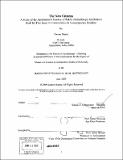The new citizens : a study of the architectural identity of public philanthropic institutions built by two Isma'ili communities in contemporary Bombay
Author(s)
Basrai, Zameer
DownloadFull printable version (42.07Mb)
Other Contributors
Massachusetts Institute of Technology. Dept. of Architecture.
Advisor
James Wescoat.
Terms of use
Metadata
Show full item recordAbstract
Just across the railway lines at Charni road, forming a backdrop to the Marine Drive, stands the Saifee Hospital in all its splendor. Across the city in the neighborhood of Mazgaon, nestled behind the St. Mary's school along the central railway line, and in an equal splendor, stands the Center of Excellence, Diamond Jubilee High School. Both buildings were built in the last five years. Both use a similar quantity of glass and cement plaster and establish their contemporaneity so. Both institutions were built by Shi'i Isma'ili communities, the hospital by the Bohras and the school by the Khojas. Both buildings represent a significant phase in the history of these mercantile communities in Bombay where their emergence as public philanthropists echoes the rapid increase in wealth and the creation of global diasporic networks in a liberal Indian economy. But while the Saifee hospital is cloaked in its massive pastel colored facade punctured by numerous arched windows and capped by ornamental domes, the Diamond Jubilee High School displays a playful juxtaposition of geometrical forms and volumes with dashes of color composed so as to expose structure and skin. The thesis explains how these two buildings, which have such different appearances, are comparable strategies for expressing Isma'ili communal identity. In Chapter two, I construct a detailed comparison of the two buildings with respect to their location in the city, aspects of siting, faqade, interior, spatial organization, program, client and architect teams. (cont.) In Chapter three, I investigate and conclude that the two institutions mediate Isma'ili faith, citizenship and mercantilism in architecturally different but functionally comparable ways that respond to the complex social 'condition' in contemporary Bombay. This thesis thus studies the expression of communal identity through its patronage of public architecture. It claims that architecture is instrumental in the creation, sustenance and subversion of communal identity and is an effective social construction used to communicate within the public sphere. I argue that for post-partition Indian Muslims, to contend with their identity in a rising tide of Hindu nationalism in the country, requires mediation of faith, citizenship and in the case of the Isma'ilis, mercantilism. Isma'ili public philanthropy, I propose, is a mode for expressing this communal identity. I explain Isma' ili architectural expression as a product of a condition distinctive of contemporary Bombay, where the simultaneous marginalization of the two Isma'ili communities by the Hindus and the other Muslims, creates a space for them to perform within the public sphere.
Description
Thesis (S.M.)--Massachusetts Institute of Technology, Dept. of Architecture, 2009. Includes bibliographical references (p. 143-146).
Date issued
2009Department
Massachusetts Institute of Technology. Department of ArchitecturePublisher
Massachusetts Institute of Technology
Keywords
Architecture.